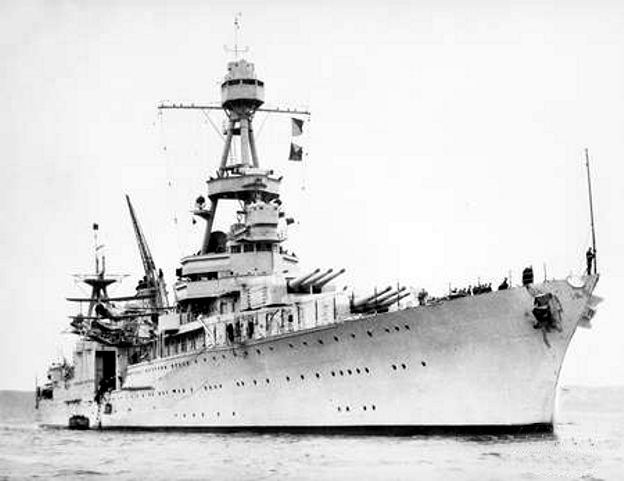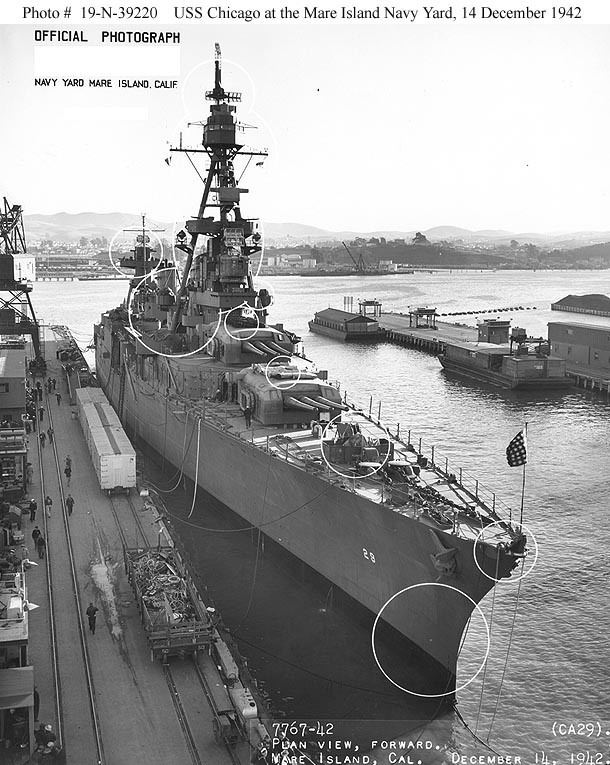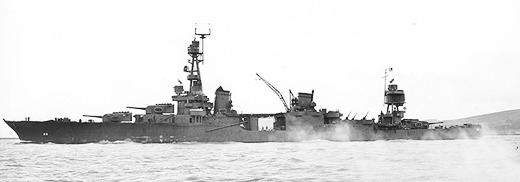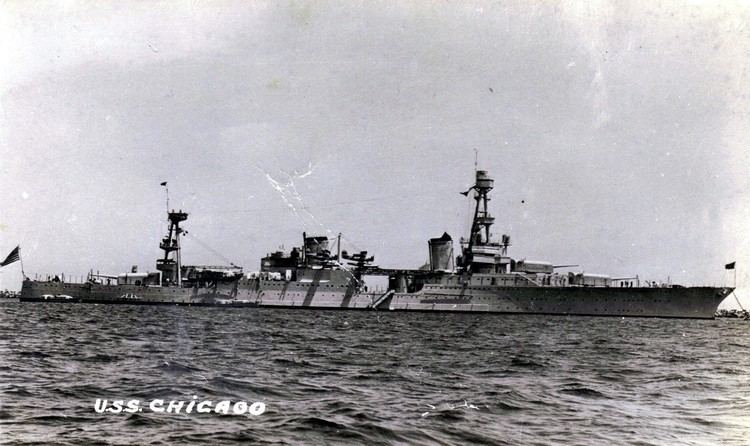Laid down 10 September 1928 Launched 10 April 1930 Beam 20 m | Ordered 18 December 1924 Construction started 10 September 1928 Length 183 m | |
 | ||
Namesake City of Chicago, Illinois Awarded 19 April 192713 June 1927 (supplementary contract) Cost $11,100,000 (limit of cost) Builders Mare Island Historic District, Vallejo | ||
Uss chicago ca 29 turret crew in action 07 1942 full
USS Chicago (CL/CA-29) was a Northampton-class cruiser of the United States Navy that served in the Pacific Theater in the early years of World War II. She was the second US Navy ship to be named after the city of Chicago. After surviving a midget submarine attack at Sydney Harbour and serving in battle at the Coral Sea and Savo Island in 1942, she was sunk by Japanese aerial torpedoes in the Battle of Rennell Island, in the Solomon Islands, on 30 January 1943.
Contents
- Uss chicago ca 29 turret crew in action 07 1942 full
- Construction
- Inter War Period
- World War II
- Loss at the Battle of Rennell Island
- Awards
- References

Construction

Chicago was launched on 10 April 1930 by Mare Island Naval Shipyard, sponsored by Miss E. Britten; and commissioned on 9 March 1931, Captain Manley Hale Simons in command. Originally classified as a light cruiser, CL-29, because of her thin armor. Effective 1 July 1931, Chicago was redesignated a heavy cruiser, CA-29, because of her 8-inch guns in accordance with the provisions of the London Naval Treaty of 1930.
Inter-War Period
After a shakedown cruise to Honolulu, Tahiti and American Samoa, Chicago departed Mare Island on 27 July 1931 and sailed to the east coast, arriving at Fort Pond Bay, New York, on 16 August. There, she became flagship of Commander, Cruisers, Scouting Force, and operated with that force until 1940.

In February 1932, Chicago conducted gunnery exercises with other ships of the Scouting Force preliminary to Fleet Problem XIII off the California coast. The Fleet was based on the West Coast thereafter and, until 1934, operated in the Pacific, from Alaska to the Panama Canal Zone and the Hawaiian Islands.

On 24 October 1933, Chicago collided with the British freighter Silver Palm in dense fog off Point Sur, California. Three officers aboard Chicago were killed in their quarters during the collision and an enlisted man's arm had to be amputated as well. Silver Palm penetrated around 18 feet into the cruisers port bow, forward of the Number 1 gun mount. At the time of the incident damage was estimated to be around $200,000 ($3.7 million today).

In 1934, the annual fleet exercises were held in the Caribbean, followed in May 1934 by the Presidential Fleet Review in New York Harbor. The Scouting Force operated along the east coast and in the Caribbean until October and then returned to base at San Pedro, California. Chicago was one of six ships to receive the new RCA CXAM radar in 1940. Chicago continued to operate out of San Pedro until 29 September 1940, when she sailed to Pearl Harbor.
During the next 14 months, Chicago operated out of Pearl Harbor, exercising with various task forces to develop tactics and cruising formations, and cruising to Australia and to the west coast.
World War II
When the Japanese attacked Pearl Harbor on 7 December 1941, Chicago was at sea with Task Force 12 and the Force immediately began a five-day sweep in the Oahu-Johnston-Palmyra triangle in an effort to intercept the enemy. The Force returned to Pearl Harbor on 12 December; from 14–27 December, Chicago operated with Task Force 11 on patrol and search missions.
On 2 February 1942, Chicago departed Pearl Harbor for Suva Bay where she joined the newly formed ANZAC Squadron, later redesignated as Task Force 44. During March and April, the cruiser operated off the Louisiade Archipelago, covering the attacks on Lae and Salamaua, New Guinea. In a position to intercept enemy surface units which attempted to attack Port Moresby, Chicago also provided cover for the arrival of American troops on New Caledonia.
On 1 May, Chicago was ordered from Nouméa to join Commander, Southwest Pacific, and on the 4th she supported Yorktown in her strike against the Japanese on Tulagi, Solomon Islands during the Battle of the Coral Sea. On 7 May, she proceeded, with the Support Group, to intercept and attack the Japanese Port Moresby invasion group. The following day, the group underwent several Japanese air attacks, during which Chicago suffered several casualties from strafing, but drove off the planes and proceeded ahead until it was clear that the Japanese force had been turned back.
On the night of 31 May – 1 June, while in port in Sydney Harbour, Australia, Chicago fired on an attacking Japanese midget submarine. Chicago's captain, Howard D. Bode, was ashore when his ship opened fire. After coming back aboard on his gig, he initially accused all the officers of being drunk. Shortly afterwards, the presence of the submarine was confirmed. Three Japanese midget submarines had attacked Sydney Harbour. One became entangled in an anti-submarine boom net, and two were able to pass through. One was then disabled by depth charges, but the other managed to fire two torpedoes at Chicago. One torpedo passed near Chicago and destroyed another vessel nearby, while the second torpedo failed to detonate, and skidded ashore onto Garden Island.
During June and July 1942, Chicago continued to operate in the Southwest Pacific. From 7–9 August, she supported the initial landings on Guadalcanal and others of the Solomon Islands, beginning the US counter-offensive against Japan. On 9 August, she engaged in the Battle of Savo Island. Early in the engagement a hit from a Japanese destroyer's torpedo caused minor damage to the ship's bow. Chicago fought damage while continuing to engage until contact with the enemy was lost. Capt. Bode's actions during the engagement were questioned in a subsequent inquiry headed by Admiral Hepburn. Though the report was not intended to be made public, Bode himself learned of its implications and shot himself on 19 April 1943, dying the following day.
After Savo Island, Chicago was repaired at Nouméa, Sydney, and San Francisco, where she arrived 13 October.
Loss at the Battle of Rennell Island
Early in January 1943, Chicago departed San Francisco, action-bound once more. On 27 January, she sailed from Nouméa to escort a Guadalcanal convoy. On the night of the 29th, as the ships approached that bitterly contested island, Japanese aircraft attacked the force and the Battle of Rennell Island was underway. During the attacks, two burning Japanese planes silhouetted Chicago, providing light for torpedo attacks; two hits caused severe flooding and loss of power. By the time the attack ended, fine work on board had checked Chicago's list. Louisville took the disabled ship in tow, and was relieved by the Navajo the following morning. During the afternoon, the Japanese attacked again and, despite heavy losses, managed to hit the disabled cruiser with four more torpedoes which sank her at 11°25′S 160°56′E.
The Japanese widely publicized the results of the engagement, claiming to have sunk two battleships and three cruisers, while only Chicago and a destroyer, USS De Haven (DD-469), were lost. The U.S. did not initially report the loss of Chicago to the public for some time, with Admiral Chester Nimitz—commander in chief of Allied Pacific forces—threatening to "shoot" any of his staff who leaked the loss to the press. Details of the battle emerged in US newspapers as early as 16 February 1943.
Awards
Chicago received three battle stars for World War II service.
